Ageing and sexing details:
|
JAN - JUL: after-second-year
male |
As is the case for most warblers, ASY males are the most boldly marked of all age/sex classes. Male Myrtle Warblers are readily recognized by having a black mask, and distinct yellow patches on the side of the breast contrasting with adjacent black feathers. ASY males tend to have a darker head and are uniformly gray-blue on the neck and back, whereas SY males usually show some retained brown in those areas.

A typical ASY male Myrtle Warbler, with bold yellow and black on the breast, and a solid black mask.
Photo by Marcel Gahbauer,
McGill Bird Observatory (QC), May 2006
Audubon's Warblers are similar in appearance, the most noticeable
differences being the yellow instead of white throat, as well as more white on the wings and the lack of a pale supercilium or distinct facial mask.
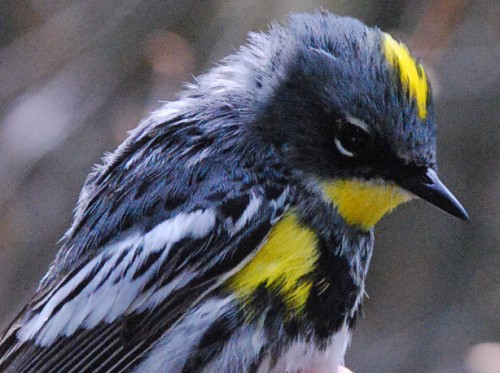 A typical ASY male Audubon's Warbler, with a solid dark grayish-blue head and yellow throat.
A typical ASY male Audubon's Warbler, with a solid dark grayish-blue head and yellow throat.
Photo by Manon Dubé,
Banff National Park (AB), May 2007
ASY males have a generally bluish-gray wing, lacking brown. The blackish greater coverts contrast with the rest of the wing, but not as strongly as on SY birds. The primary coverts tend to be relatively broad and rounded, and usually have silvery gray edging.
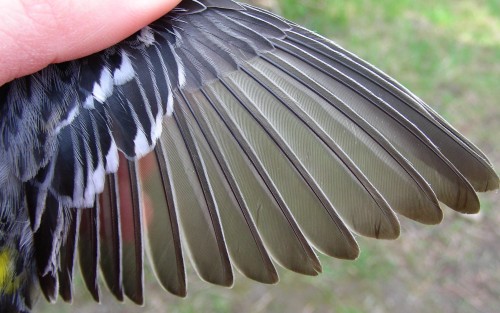
A typical AHY wing; note the silvery edging on the dark primary coverts.
Photo by Marie-Anne Hudson,
McGill Bird Observatory (QC), May 2008
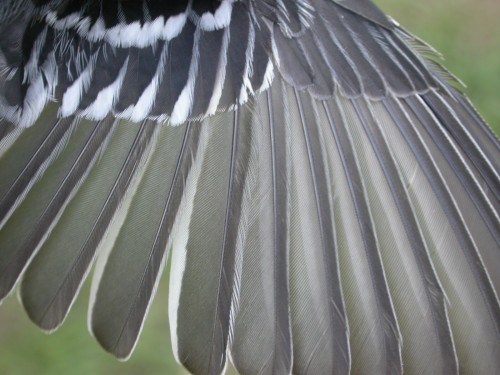
A closer view of an ASY male wing, again showing broad and rounded greater coverts
with silvery edging. Note that in this case there is a contrast between the outermost three
basic greater coverts
and the slightly darker and fresher inner alternate greater coverts;
this is a result of the prealternate molt and provides no clues about age.
Photo by Marcel Gahbauer,
McGill Bird Observatory (QC), May 2006
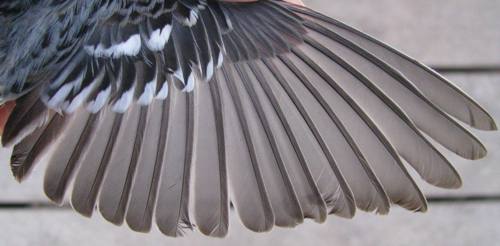
Another ASY male Myrtle Warbler, with the edging of the primary coverts a bit less prominent.
Photo by Peter Pyle,
Delta Marsh Bird Observatory (MB), May 2009
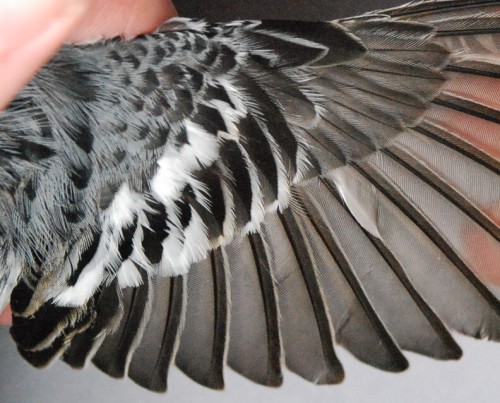
An ASY male Audubon's Warbler, similar to the Myrtle Warbler examples above, but
note the more extensive white edging to the inner greater coverts that have been
replaced during the prealternate molt.
Photo by Manon Dubé,
Banff National Park (AB), May 2007
ASY Yellow-rumped Warblers tend to have relatively broad, rounded, and fresh rectrices compared to SY individuals. ASY males have largely black uppertail coverts, with gray-blue edging that may be largely worn off by spring, especially toward the tips. On average they have more white on the tail than other age/sex classes.
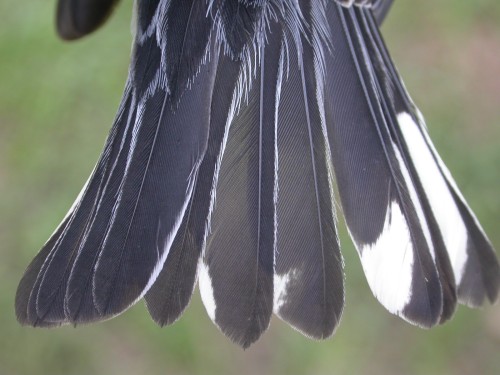
An ASY male Myrtle Warbler with blackish rectrices that are broad and rounded and have
extensive white
on the outermost three rectrices, plus some on r3 and even r2; note also the
uppertail
coverts that are almost entirely black, with a bit of gray-blue edging.
Photo by Marcel Gahbauer,
McGill Bird Observatory (QC), May 2006
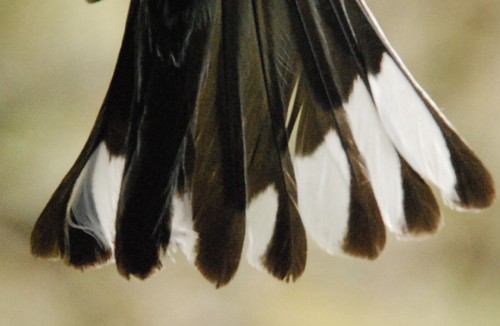
An ASY male Audubon's Warbler; note that it has more white on the tail than Myrtle Warblers,
with ASY males usually having a bit of white on at least r2 through r6.
Photo by Manon Dubé,
Banff National Park (AB), May 2007
RETURN TO AGE/SEX
OVERVIEW
|
JAN - JUL: after-second-year
female |
ASY
females are distinctly paler than males, with the yellow and black markings on the breast much more limited. Distinctions between SY and ASY females can be subtle, and usually a good look at the wing and tail is required to determine age.
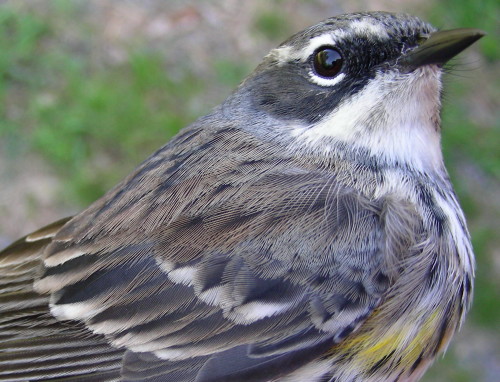
A typical ASY female Myrtle Warbler, with a bit of yellow and some black streaking on
the breast, a dark gray to blackish facial mask, and a mottled brown-gray back.
Photo by Marie-Anne Hudson,
McGill Bird Observatory (QC), May 2009
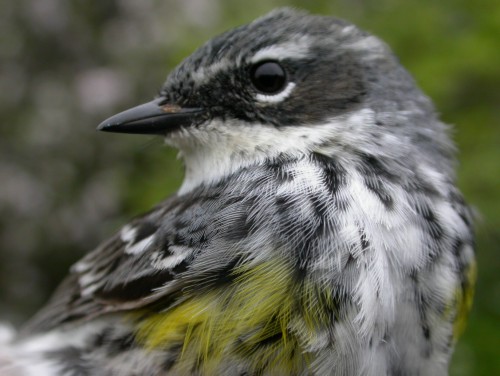
More of a frontal view, again highlighting the dull facial mask and diffuse yellow and
black markings on the breast.
Photo by Marcel Gahbauer,
McGill Bird Observatory (QC), May 2005
The
wing of ASY females is paler and duller than that of ASY males, but again there is a contrast between the greater coverts and primary coverts that is more subtle than that seen on SY birds. ASY females also have pale silvery edging to the relatively broad and rounded primary coverts.
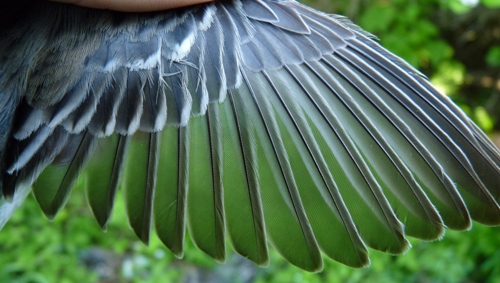
A typical ASY female wing, with a subtle contrast between the greater and primary coverts,
and distinct edging to the primary coverts.
Photo by Simon Duval,
McGill Bird Observatory (QC), May 2010
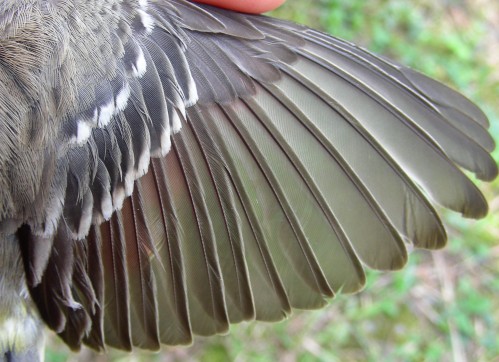
Another ASY female Myrtle Warbler, this one with less edging on the primary coverts, but
the overall quality of the wing still more uniform than would be seen on SY females.
Photo by Marie-Anne Hudson,
McGill Bird Observatory (QC), May 2008
ASY Yellow-rumped Warblers tend to have relatively broad, rounded, and fresh rectrices compared to SY individuals. The uppertail coverts of ASY females have moderately to very wide black centres with largely blue-gray edging, but usually also some brown. On average they have an intermediate amount of white on the tail.
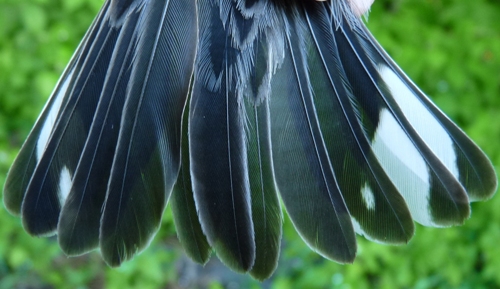
The tail of an ASY female Myrtle Warbler, showing broad and rounded rectrices with a fair
amount of white on r5 and r6, and a bit extending to r4; the uppertail coverts are mostly
black and with barely any brown along the edge, which is relatively uncommon for females.
Photo by Simon Duval,
McGill Bird Observatory (QC), May 2010
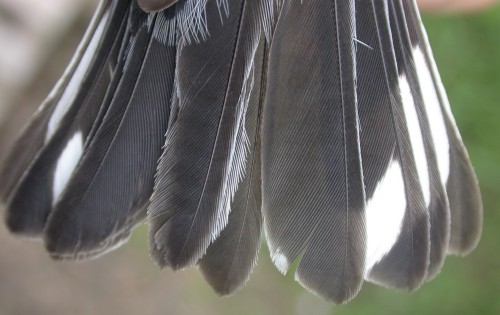
Another ASY female Myrtle Warbler, with a bit more white on r4.
Photo by Marcel Gahbauer,
McGill Bird Observatory (QC), May 2005
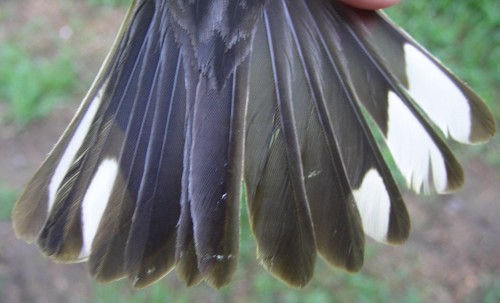
A third ASY female Myrtle Warbler, with still more white on r4, but note that in this case the
uppertail coverts have a narrower black centre, and more brown along the edges.
Photo by Marie-Anne Hudson,
McGill Bird Observatory (QC), May 2007
RETURN TO AGE/SEX
OVERVIEW
|
JAN - JUL: second-year
male |
SY males are generally quite similar in overall appearance to ASY males, also featuring distinct yellow and black patches on the breast. In some cases the facial mask is not as black as on ASY males, and often SY males can be easily recognized by the presence of brown feathers contrasting with the otherwise blue-gray back.
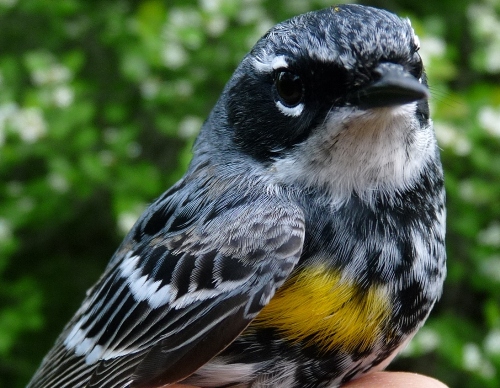
A particularly boldly coloured SY male Myrtle Warbler, with a solid black mask, and only
a bit of brownish-gray visible on the shoulders and back.
Photo by Marcel Gahbauer,
McGill Bird Observatory (QC), May 2010
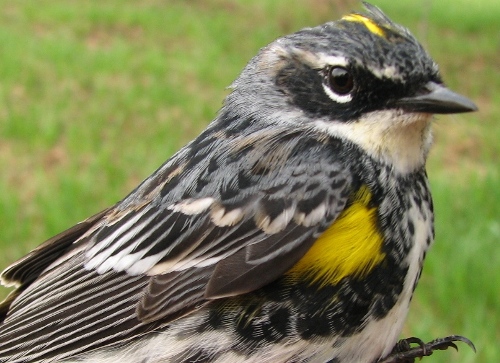
A typical SY male Myrtle Warbler, with small patches of brown on the back and crown,
and the facial mask blackish rather than the solid black typical of ASY males.
Photo by Barbara Frei,
McGill Bird Observatory (QC), April 2008
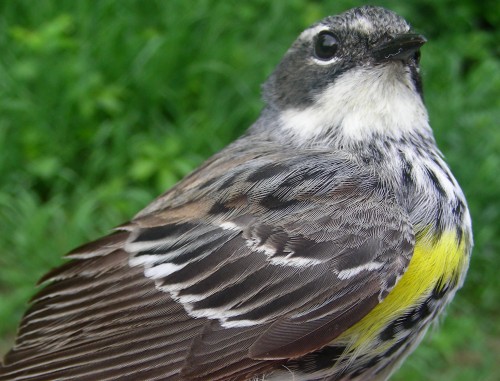
A pale SY male, with a grayish facial mask and a fair amount of brown on the back.
Photo by Marie-Anne Hudson,
McGill Bird Observatory (QC), May 2007
Audubon's Warbler differs by having a yellow throat instead of white.
Also, SY males tend to have less brown than SY male Myrtle Warblers.
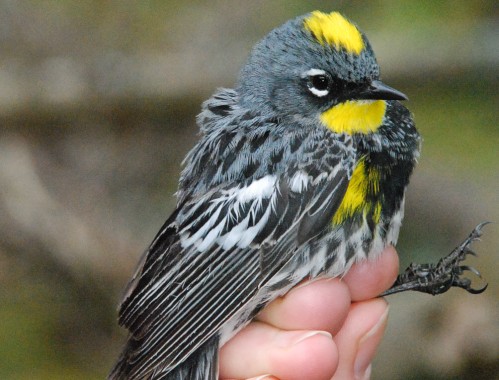
An SY male Audubon's Warbler, from this view indistinguishable from an ASY male.
Photo by Manon Dubé,
Banff National Park (AB), May 2007
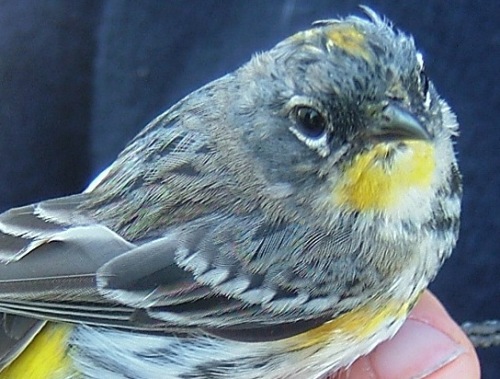
An SY male Audubon's Warbler earlier in spring, showing a lot more brown than the
previous example, probably suggesting the prealternate molt has not yet completed.
Photo by Peter Pyle, San Francisco Bay Bird Observatory (CA), April 2006
SY male Yellow-rumped Warblers have a duller wing than ASY males, usually with a brownish tone to the retained juvenile primary coverts, primaries, and secondaries. The primary coverts have minimal edging, which if present is more brownish than silvery-gray. There is usually a distinct contrast between the blackish inner greater coverts and brown, relatively worn tertials.
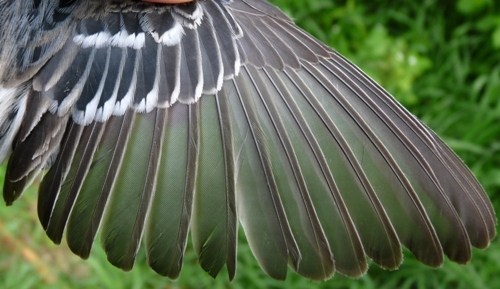
A typical SY Myrtle Warbler wing, with three generations of feathers present: five blackish
inner greater coverts that were replaced during the prealternate molt, the remaining dark
greater coverts that were replaced during the preformative molt, and the paler block of
brownish juvenile feathers comprising the primary coverts, primaries, and secondaries. Note
in particular the brownish and frayed tertials, in contrast with the alternate greater coverts.
Photo by Marcel Gahbauer,
McGill Bird Observatory (QC), May 2010
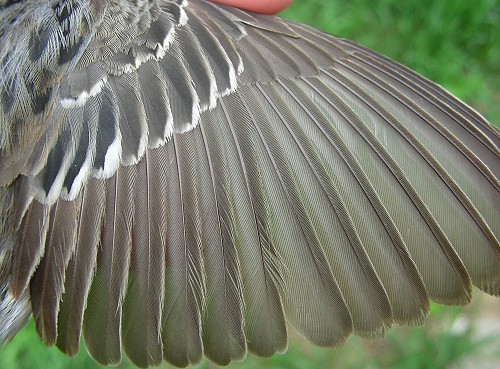
Another SY male Myrtle Warbler wing showing three generations of feathers, in this case
all within the greater coverts, as the outermost feather in that tract is still a juvenile feather,
contrasting with the formative greater coverts to the left, as well as the replaced formative
carpal covert to the right. Note again the brownish tone of the primaries and secondaries,
and the lack of edging on the primary coverts.
Photo by Marie-Anne Hudson,
McGill Bird Observatory (QC), May 2007
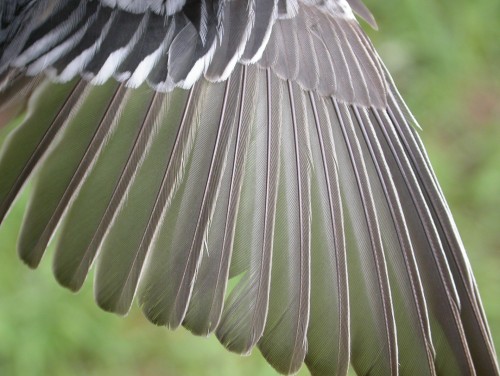
A closer view, highlighting an example where all greater coverts appear to have been
replaced during the prealternate molt, and there are therefore only two generations of
feathers visible, as all formative feathers have been replaced. Such a wing can be more
easily mistaken for an ASY bird, but note that the primaries and secondaries are still
quite brownish, and the minimal edging on the primary coverts is also pale brown.
Photo by Marcel Gahbauer,
McGill Bird Observatory (QC), May 2006
Patterns are similar on SY male Audubon's Warbler, though retained juvenile feathers tend to be a bit more grayish than on Myrtle Warblers, and the alternate greater coverts have broader white edging.
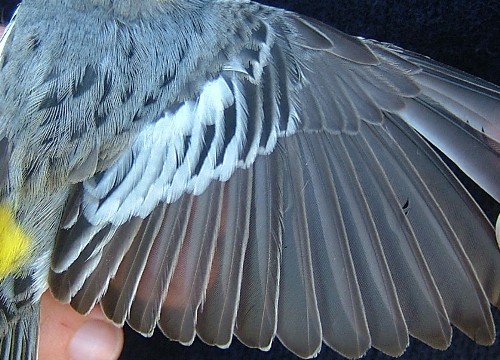
The broad white edging on the alternate greater coverts makes this wing appear more
boldly marked than the SY Myrtle Warblers above, but note the strong contrast between
the outer greater coverts and primary coverts, and the generally brownish tone of the
primary coverts, primaries, and secondaries.
Photo by Peter Pyle, San Francisco Bay Bird Observatory (CA), April 2006
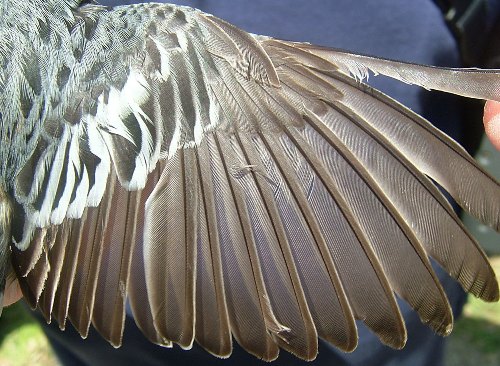
The colours in this photo are a bit skewed by the direct sunlight, but again it is readily
recognizable as an Audubon's Warbler SY male by the strong contrast between the
blackish greater coverts and distinctly brown secondaries (and the same contrast
occurring among the tertials), as well as the brown primary coverts lacking edging.
Photo by Peter Pyle, Big Sur Ornithology Lab (CA), April 2005
SY Yellow-rumped Warblers tend to have somewhat narrower and more pointed rectrices than ASY individuals. On males, the uppertail coverts usually have large black centres with mostly bluish-gray edging; there is usually some brown too, but it may have largely worn off by spring. SY male Myrtle Warblers usually have white patches on at leas the three outer rectrices (r4-r6).
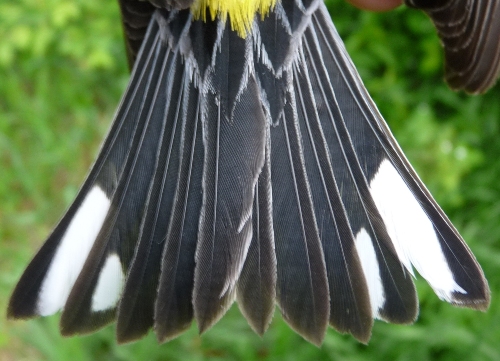
A typical SY male Myrtle Warbler tail, with relatively narrow rectrices compared to ASY
birds, and mostly black uppertail coverts, with a hint of brown on the edge of some.
Photo by Marcel Gahbauer,
McGill Bird Observatory (QC), May 2010
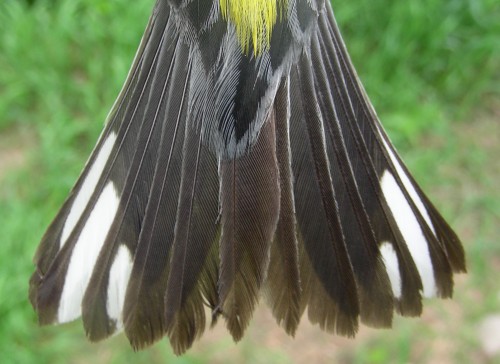
Another SY male Myrtle Warbler, illustrating that the tail can be somewhat brownish and
faded, contrasting with the uppertail coverts.
Photo by Marie-Anne Hudson,
McGill Bird Observatory (QC), April 2007
Audubon's Warblers tend to have more extensive
white patches on the tail than Myrtle Warblers of the same age/sex.
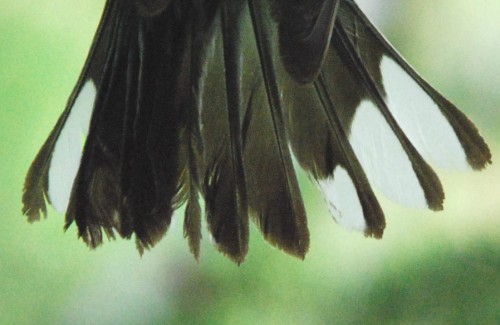
The pattern on this SY male Audubon's Warbler is similar to the Myrtle Warbler examples
above, but the white patch on r4 is more extensive.
Photo by Manon Dubé,
Banff National Park (AB), May 2007
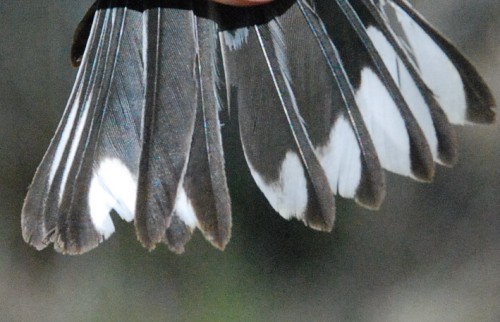
This example more clearly shows the greater extent of white on the tail of SY male
Audubon's Warblers, with some on all rectrices except r1. Note, however, that
the rectrices are still relatively narrow, and could likely be separated from ASY
males with a similar colour pattern based on shape.
Photo by Manon Dubé,
Banff National Park (AB), May 2007
RETURN TO AGE/SEX
OVERVIEW
|
JAN - JUL: second-year
female |
SY female Yellow-rumped Warblers are on average the dullest age/sex class, often with a fair amount of brown on the head and back. However, some individuals with les brown in these areas may superficially look more like ASY females, requiring closer review of the wing and tail to assess age..
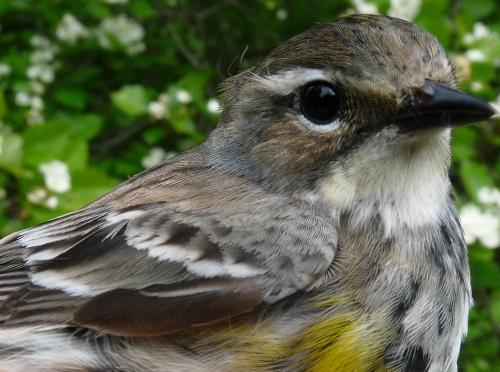
A typical SY female, with a fair amount of brown on the head and back, hardly any
facial mask, and a limited amount of yellow and black on the breast.
Photo by Marcel Gahbauer,
McGill Bird Observatory (QC), May 2010
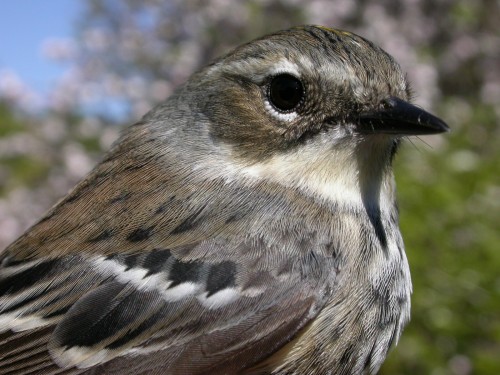
Another SY female Myrtle Warbler, with even less yellow on the breast.
Photo by Marcel Gahbauer,
McGill Bird Observatory (QC), May 2005
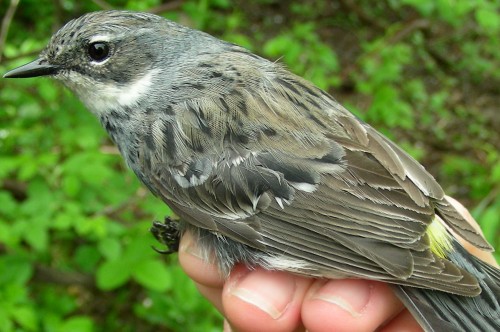
An SY female Myrtle Warbler with more gray on the head, but note the strong contrast
between the pale brown and very worn juvenile flight feathers with the fresher gray
feathers
of the greater coverts and the back (the contrast is rarely this apparent).
Photo by Marie-Anne Hudson,
McGill Bird Observatory (QC), May 2008
SY female Yellow-rumped Warblers have a wing pattern similar to that of SY males, but a bit browner. In most cases this provides the best way to separate SY and ASY females, but in cases where all greater coverts have been replaced during the prealternate molt, the appearance of the SY wing may look more similar to the ASY pattern, and extra caution is required. As with males, SY females have minimal edging on the primary coverts, which if present if more of a beige-brown than silvery-gray. There is usually a contrast between the dark gray inner greater coverts and the browner, relatively worn tertials.
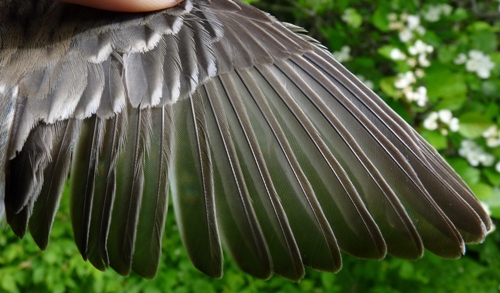
A relatively "good" wing for an SY female Myrtle Warbler, with relatively little wear, but
still note the overall brownish tone, and the minimal beige
edging to the primary coverts.
Photo by Marcel Gahbauer,
McGill Bird Observatory (QC), May 2010
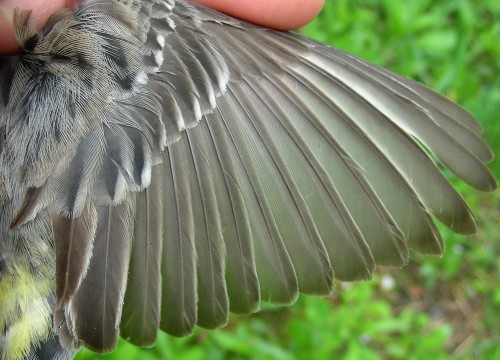
A more typical SY female Myrtle Warbler wing. Note the strong contrast between the inner
greater coverts and the very pale and worn tertials, as well as the three generations of
feathers present among the coverts (three alternate inner greater coverts that are darker
and longer than the remaining formative greater coverts, which are in turn darker and
fresher than the retained juvenile primary coverts).
Photo by Marie-Anne Hudson,
McGill Bird Observatory (QC), May 2008
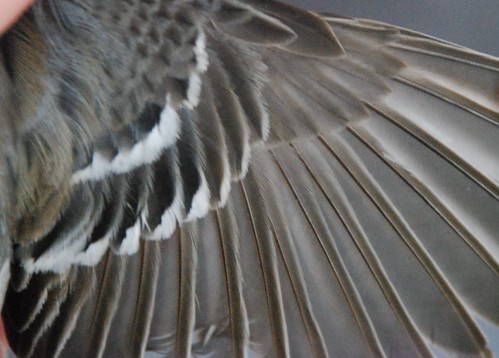
A closer view of an SY female Audubon's Warbler; note again the three generations of
coverts, but in this case the alternate greater coverts are darker and with more white
edging, as is characteristic of all age/sex classes for Audubon's Warbler.
Photo by Manon Dubé,
Banff National Park (QC), May 2007
SY females have the palest tail of any age/sex class, and with the most restricted amount of white, often just on r5 and r6 in Myrtle Warblers, but extending as far as r4 on some individuals (and on most Audubon's Warblers). The uppertail coverts have narrow to moderately wide black centres, usually with some brown edging, although it may have worn off by spring.
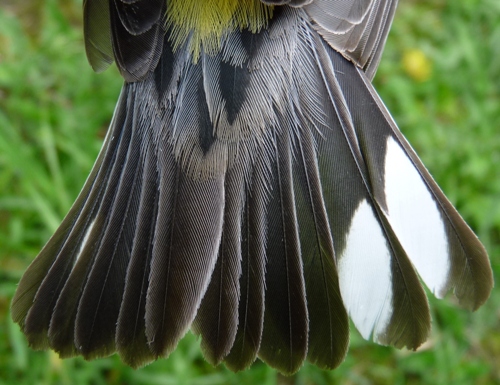
A typical SY female Myrtle Warbler tail except for the relatively broad and rounded shape
of the outer rectrices, which is more suggestive of an ASY bird. However, note that white
is limited to r5 and r6 (ASY females would be expected to have at least some white on
r4) and that there is a fair amount of brown on the uppertail coverts.
Photo by Marcel Gahbauer,
McGill Bird Observatory (QC), May 2010
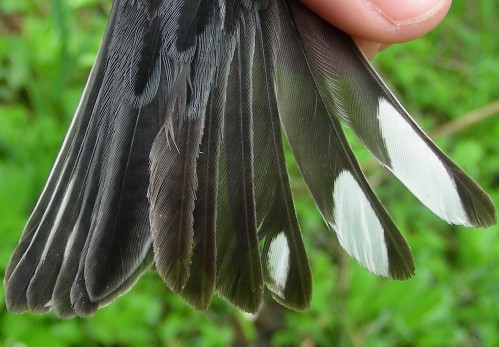
A more typical SY female tail in terms of shape, but this time with no brown edging
visible on the edging of the uppertail coverts.
Photo by Marie-Anne Hudson,
McGill Bird Observatory (QC), May 2008
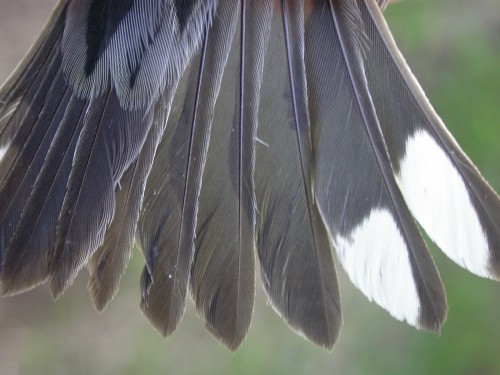
Another SY female Myrtle Warbler with relatively narrow rectrices, and with white limited to
just the outermost two feathers, but with uppertail coverts that could easily be mistaken
for those of an ASY female or SY male; given that evidence is often conflicting, it is
important to take all clues into consideration, especially the wing.
Photo by Marcel Gahbauer,
McGill Bird Observatory (QC), May 2005
RETURN TO AGE/SEX
OVERVIEW
|
JUL - DEC: after-hatch-year
male |
All Myrtle Warblers have predominantly brownish upperparts in fall, but AHY males tend to have the greatest amount of blue-gray on the wings, back and sometimes even the crown. Additionally, AHY males are the only age/sex class in fall to sometimes have traces of black in the lores or auricular. The amount of yellow on the breast and crown is also on average greatest on AHY males, but this sufficiently variable that it is of limited use.
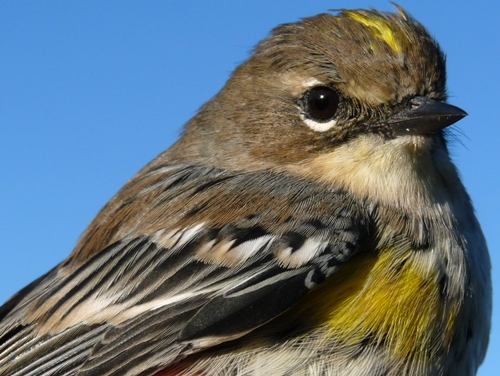
A distinct AHY male Myrtle Warbler, with blackish lores, a bit of blue-gray on the crown
as well as on the back and wings, and distinct yellow patches on the breast and crown.
Photo by Marcel Gahbauer,
McGill Bird Observatory (QC), October 2010
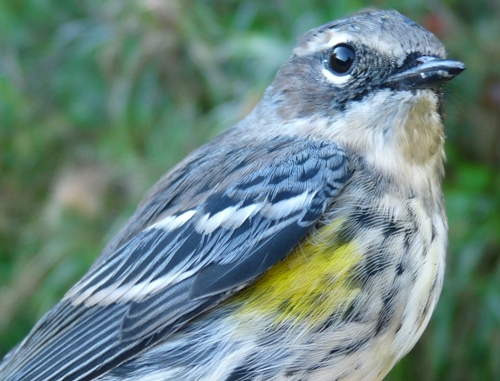
Another AHY male Myrtle Warbler, this one with a bit more black on the face, but somewhat
less yellow; again there is a fair amount of blue-gray plumage visible.
Photo by Marcel Gahbauer,
McGill Bird Observatory (QC), October 2010
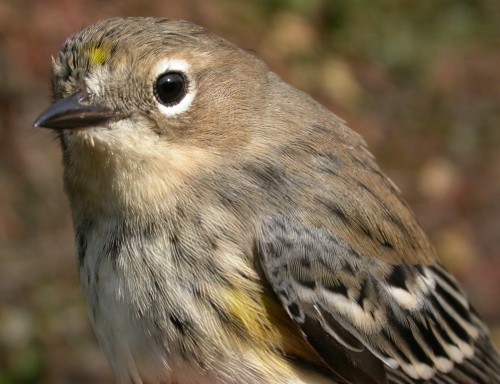
A somewhat paler AHY male, with no black on the face, and only faint yellow on the side
of the breast, but note the wing still shows a fair amount of blue-gray.
Photo by Marcel Gahbauer,
McGill Bird Observatory (QC), October 2005
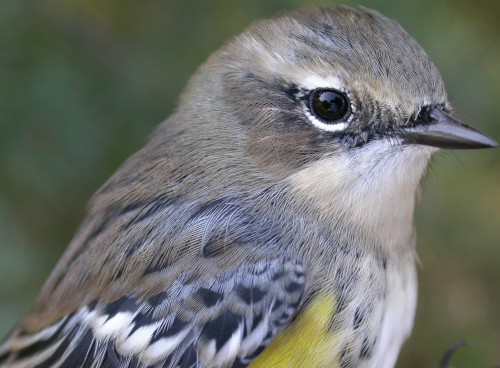
This AHY male has a somewhat browner appearance overall, but still has traces of
the black facial mask to complement the blue-gray wings.
Photo by Marcel Gahbauer,
McGill Bird Observatory (QC), October 2005
AHY males have the darkest wings of all age/sex classes. There is generally a pseudolimit between the blackish greater coverts and the dark gray primary coverts, but note that the contrast tends to be less pronounced than on HY males, and the primary coverts of AHY males are broader and with silvery edging.
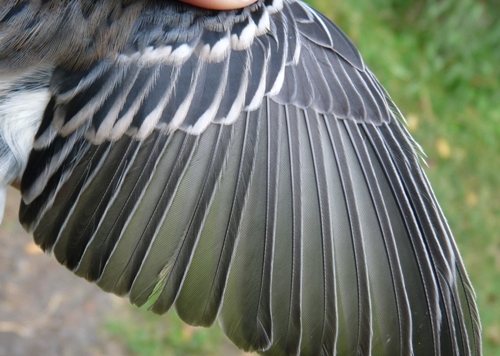
A typical AHY male Myrtle Warbler wing, dark overall, with the primary coverts broad and
fairly rounded and featuring distinct silvery edging.
Photo by Marcel Gahbauer,
McGill Bird Observatory (QC), October 2010
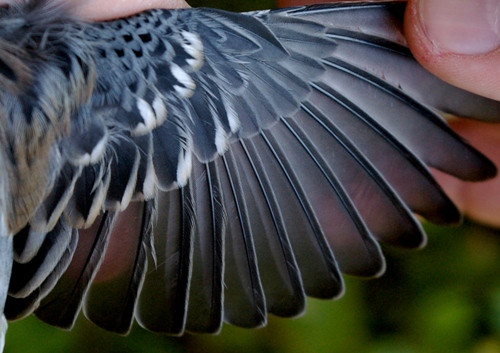
Another AHY male Myrtle Warbler, highlighting the shape and edging of the primary coverts.
Photo by James Junda,
McGill Bird Observatory (QC), September 2008
AHY males have broad and rounded rectrices with on average more extensive white patches than other age/sex classes, always including large patches on r4-r6, and often with some white on r3 as well. The uppertail coverts have large black centres with bluish
edging, occasionally with a hint of brown at the tip.
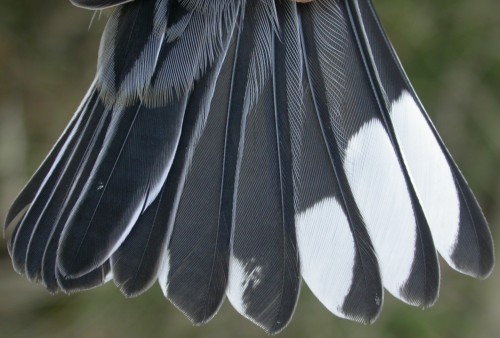
An AHY male Myrtle Warbler with a particularly extensive amount of white on the tail.
Photo by Marcel Gahbauer,
McGill Bird Observatory (QC), October 2005
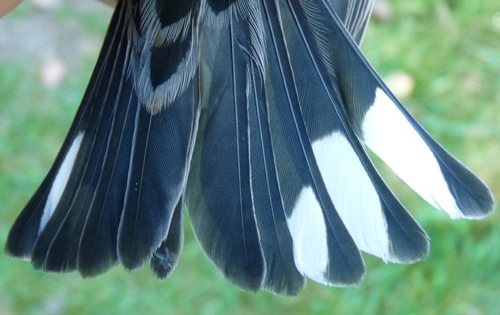
A more typical AHY male tail, though note there is still a bit of brown at the tip of the
uppertail coverts.
Photo by Marcel Gahbauer,
McGill Bird Observatory (QC), October 2010
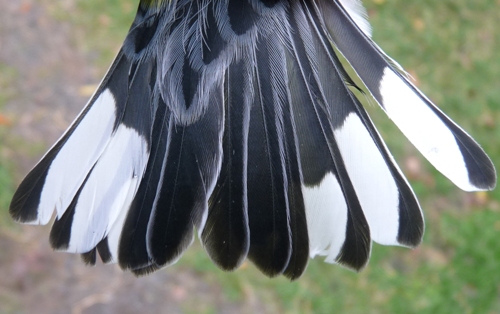
Another AHY male Myrtle Warbler, this one showing black uppertail coverts with
entirely blue-gray edging, along with dark, broad, and rounded rectrices.
Photo by Marcel Gahbauer,
McGill Bird Observatory (QC), October 2010
RETURN TO AGE/SEX
OVERVIEW
|
JUL - DEC: after-hatch-year
female |
AHY females are generally similar to AHY males, but with less blue-gray on the upperparts, lacking black in the face, and with little or no yellow on the breast. AHY females can appear quite similar to HY males, and a good look at the wing and tail may be required to separate them.
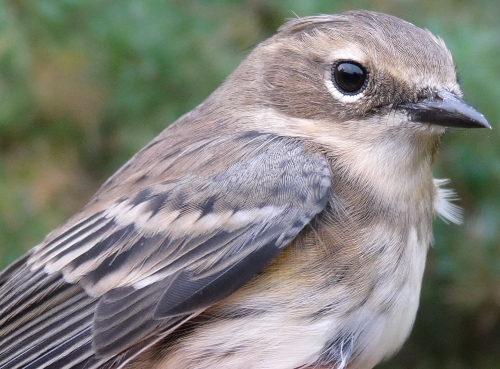
A typical AHY female Myrtle Warbler, largely brownish, but with some blue-gray on the wing.
Photo by Marcel Gahbauer,
McGill Bird Observatory (QC), October 2010
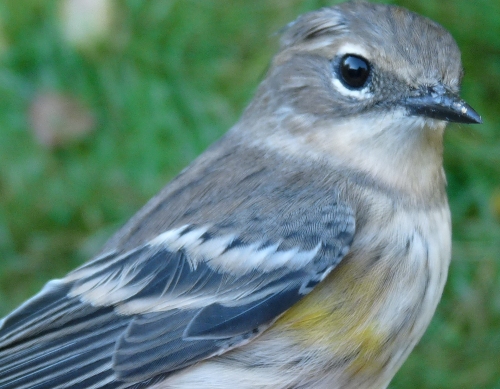
Another AHY female Myrtle Warbler, this one with a bit of yellow retained on the breast.
Photo by Marcel Gahbauer,
McGill Bird Observatory (QC), October 2010
The wings of AHY females are browner and duller than those of AHY males. However, they also have a relatively uniform appearance, other than a pseudolimit between the somewhat darker greater coverts and the paler primary coverts. The primary coverts are relatively broad and usually have some pale edging, but there can be some overlap in appearance with HY individuals.
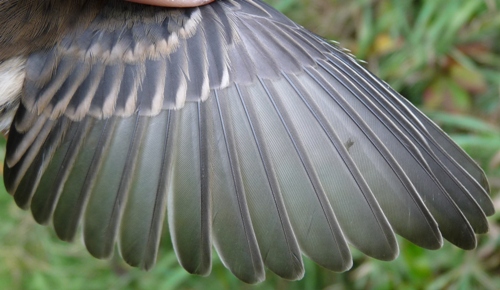
A typical AHY female wing, showing a contrast between the greater and primary coverts,
but overall relatively uniformly dark and dull.
Photo by Marcel Gahbauer,
McGill Bird Observatory (QC), October 2010
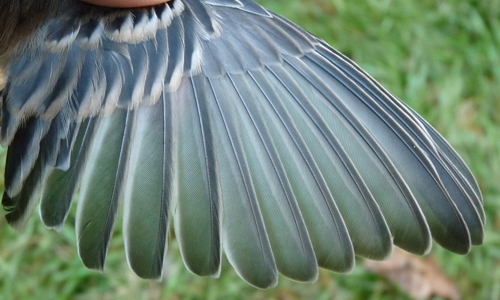
An AHY female during the final stages of a late prebasic molt.
Photo by Marcel Gahbauer,
McGill Bird Observatory (QC), October 2010
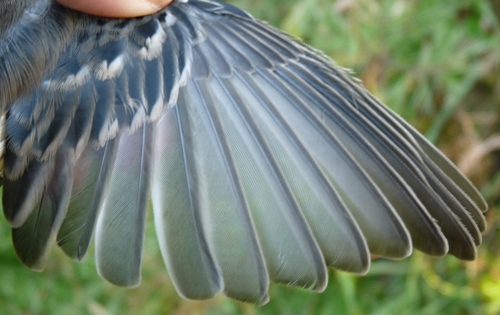
Another female Myrtle Warbler recognizable as an AHY individual by virtue of the final
secondaries growing in, indicating that it is undergoing its prebasic molt. Note that were
it not for this clue, the overall appearance of the wing could easily be mistaken for an
HY bird, as the flight feathers look quite a bit paler than the greater coverts; some birds
therefore require consideration of the tail and/or skull for ageing.
Photo by Marcel Gahbauer,
McGill Bird Observatory (QC), October 2010
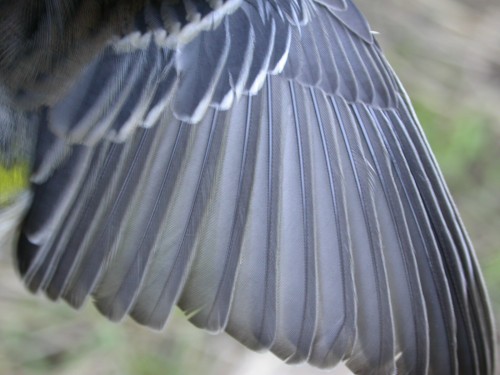
A closer view, highlighting the shape and edging of the primary coverts.
Photo by Marcel Gahbauer,
McGill Bird Observatory (QC), October 2005
AHY females have relatively broad and rounded rectrices, usually with white patches on the outermost three feathers (r4-r6), but sometimes restricted to just r5 and r6. The uppertail coverts have narrow to moderately wide black centres, with at least some brown edging.
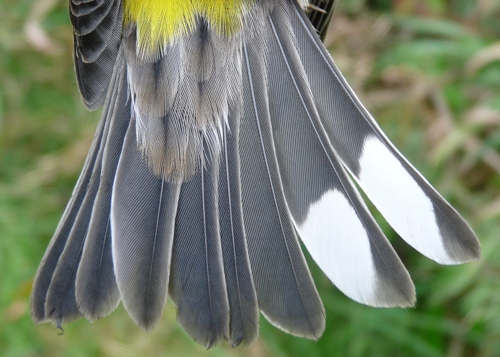
A rather pale AHY female tail, with unusually narrow black centres to the uppertail
coverts, and white limited to just the two outermost rectrices.
Photo by Marcel Gahbauer,
McGill Bird Observatory (QC), October 2010
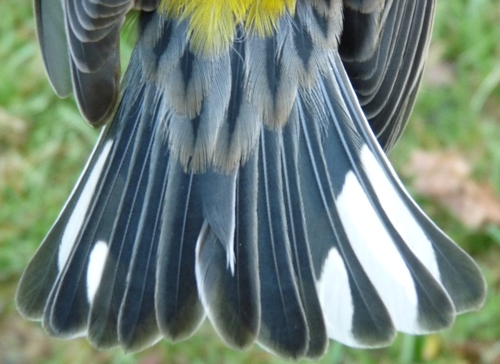
A more typical AHY female tail, with an intermediate amount of black on the uppertail
coverts, and white patches on the three outermost rectrices.
Photo by Marcel Gahbauer,
McGill Bird Observatory (QC), October 2010
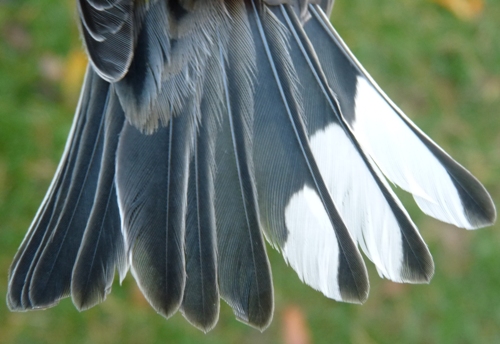
Another AHY female, with somewhat more black on the uppertail coverts, but with the
outer rectrices not quite as broad and rounded.
Photo by Marcel Gahbauer,
McGill Bird Observatory (QC), October 2010
RETURN TO AGE/SEX
OVERVIEW
|
JUL - DEC: hatch-year
male |
HY males can vary somewhat in appearance, looking quite like AHY males or females. They are generally brownish with some blue-gray on the wings and back. They may have as much yellow on the breast as some AHY males, though generally lack it on the crown. The wing and tail (and if possible, the skull) often need to be checked to be confident of age and sex.
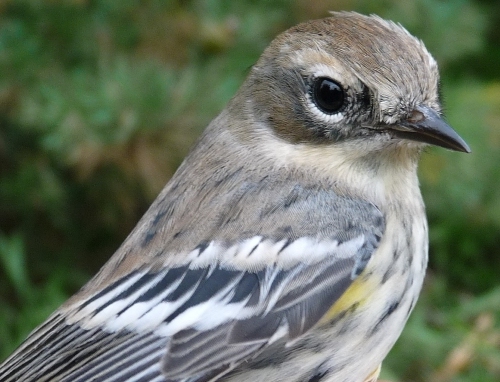
A typical HY male, with a hint of yellow on the breast, some blue-gray on the back, and a
strong contrast between the greater coverts and more brownish flight feathers.
Photo by Marcel Gahbauer,
McGill Bird Observatory (QC), October 2010
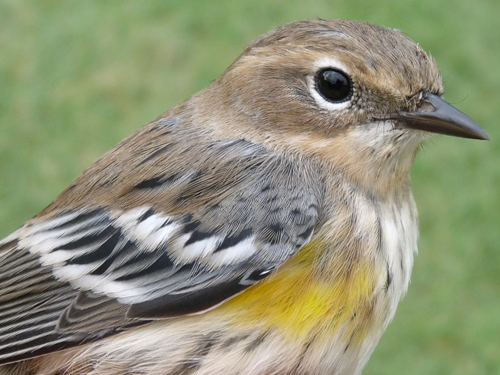
A particuarly boldly marked HY male Myrtle Warbler, with a large patch of yellow and
extensive blue-gray edging on the lesser, median, and greater coverts, but note the
contrast with the browner primary coverts.
Photo by Marcel Gahbauer,
McGill Bird Observatory (QC), October 2010
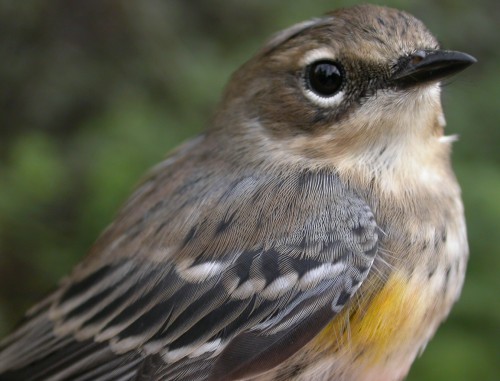
A somewhat browner HY male, but still with yellow on the breast and a fair amount of
gray-blue in the lesser and median coverts.
Photo by Marcel Gahbauer,
McGill Bird Observatory (QC), September 2005
The wing pattern on HY males is generally similar to that of AHY males, except with a greater degree of contrast between the greater coverts and the block of primary coverts, primaries, and secondaries. Occasionally one or more outer juvenile greater coverts are retained, and this molt limit can be used to easily and reliably identify individuals as HY. The primary coverts are generally dull with minimal beige edging.
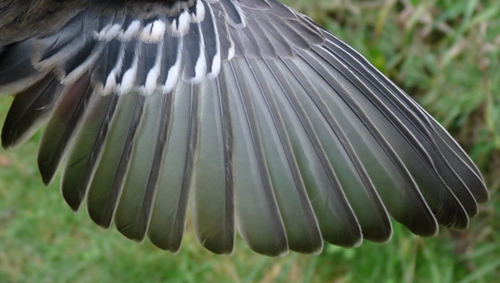
A distinct HY male Myrtle Warbler wing, with a molt limit very apparent thanks to the
outermost greater covert being a retained juvenile feather, contrasting with both the
adjacent formative greater
coverts, and the carpal covert that has also been replaced.
Photo by Marcel Gahbauer,
McGill Bird Observatory (QC), October 2010
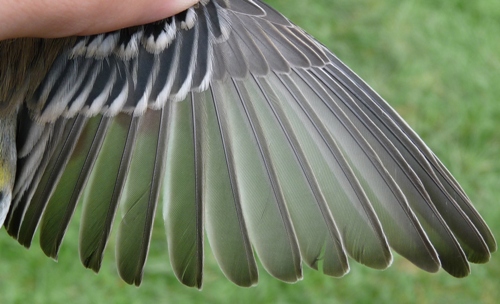
A more typical HY wing, in which the greater coverts have all been replaced during the
preformative molt. Note the relatively strong contrast between the greater coverts and the
block of brownish primary coverts, primaries, and secondaries, compared to AHY birds.
Photo by Marcel Gahbauer,
McGill Bird Observatory (QC), October 2010
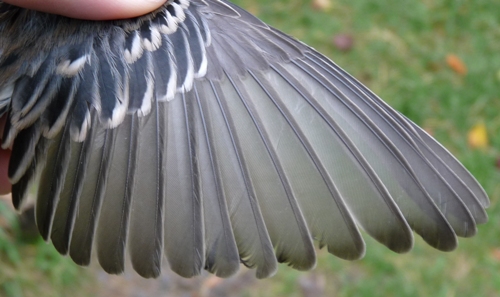
Another HY male wing, highlighting how dull and relatively pale the juvenile feathers of
the primary coverts, primaries, and secondaries appear.
Photo by Marcel Gahbauer,
McGill Bird Observatory (QC), October 2010
HY Yellow-rumped Warblers tend to have somewhat narrower rectrices than AHY birds, but there is enough overlap that shape is not always reliable. HY males often have some white extending to r4, but in some cases it is limited to r5 and r6. The uppertail coverts have a moderate to extensive amount of black, with mostly blue-gray edging, but often some brown, especially at the tips.
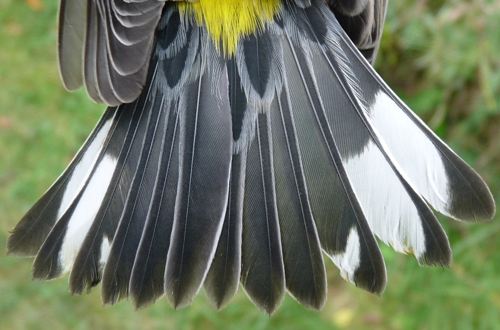
A fairly typical HY male tail in terms of colour, although the shape of the rectrices is
somewhat intermediate between what is typical of HY and AHY individuals.
Photo by Marcel Gahbauer,
McGill Bird Observatory (QC), October 2010
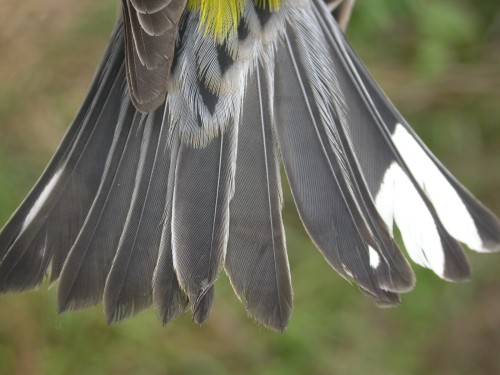
Another HY male, with a bit less white on r4 and more brown edging on the uppertail
coverts; note also the contrast of the brownish primaries visible in this photo.
Photo by Marcel Gahbauer,
McGill Bird Observatory (QC), September 2005

A comparison between HY male (left) and AHY male (right) tails, highlighting differences
in rectrix shape and the extent of white on the outer rectrices.
Photo by Marcel Gahbauer,
McGill Bird Observatory (QC), October 2010
RETURN TO AGE/SEX
OVERVIEW
|
JUL - DEC: hatch-year
female |
HY females have the dullest appearance of all Yellow-rumped Warblers, with the least amount of blue-gray, and usually little or no yellow anywhere, to the extent that they can occasionally be confused with Palm Warblers at a quick glance. However, there is enough variability in various age/sex classes that the wing and tail (and skull if possible) usually need to be viewed to be confident with ageing and sexing.
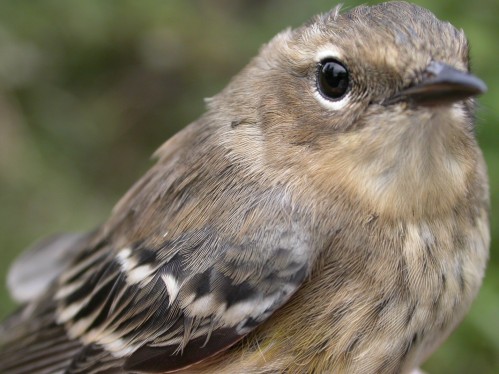
A typical HY female Myrtle Warbler, largely brownish, with only a bit of gray-blue
plumage visible on the wings.
Photos by Marcel Gahbauer,
McGill Bird Observatory (QC), September 2005
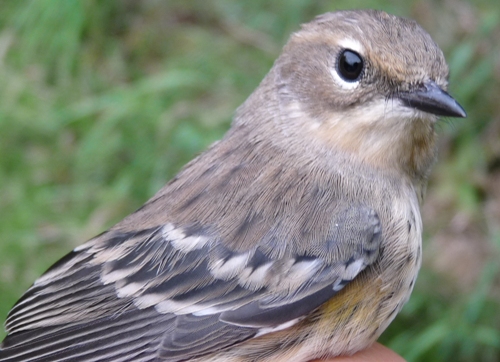
Another HY female Myrtle Warbler, this one with a hint of yellow on the breast.
Photo by Marcel Gahbauer,
McGill Bird Observatory (QC), October 2010
The wing pattern on HY females is usually similar to that of AHY females, but overall the wing is paler. Occasionally one or more outer juvenile greater coverts are retained, and this molt limit can be sued to easily and reliably identify individuals as HY. The primary coverts are generally brownish with minimal beige edging.
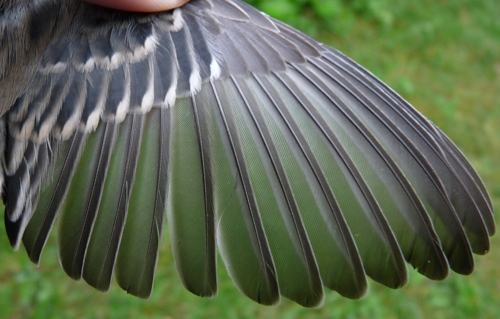
A typical HY female wing, dull overall with a molt limit between the greater coverts
and primary coverts. Note, however, that this pattern can appear quite similar to
that of AHY females, so reference to other features is recommended.
Photo by Marcel Gahbauer,
McGill Bird Observatory (QC), September 2009
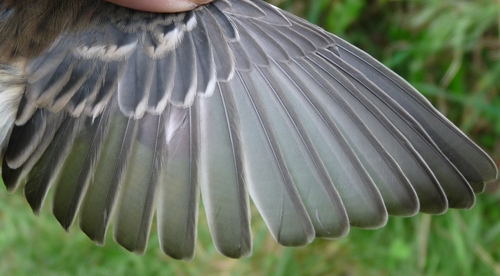
An easier HY female to identify, by virtue of the outermost juvenile greater covert being
retained and contrasting with the replaced formative greater coverts and carpal covert.
Photo by Marcel Gahbauer,
McGill Bird Observatory (QC), October 2010
HY females tend to have relatively narrow rectrices, though there are enough intermediates that shape alone is often not reliable except in particularly distinct cases. White patches are usually limited to the two outermost rectrices, but occasionally a small amount may appear on r4 as well. The uppertail coverts have a small to moderate amount of black, with a mix of gray and brown edging.
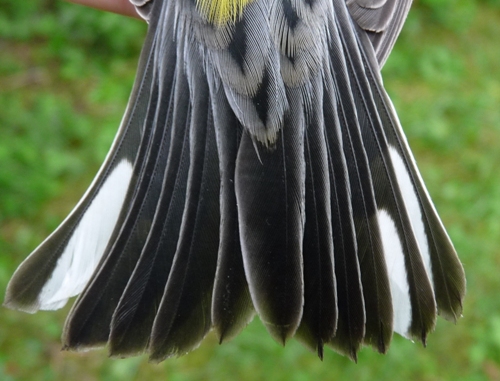
An HY female tail with relatively narrow and pointed rectrices and white limited to r5 and r6,
but relatively dark overall, with relatively little brown edging on the uppertail coverts.
Photo by Marcel Gahbauer,
McGill Bird Observatory (QC), September 2009
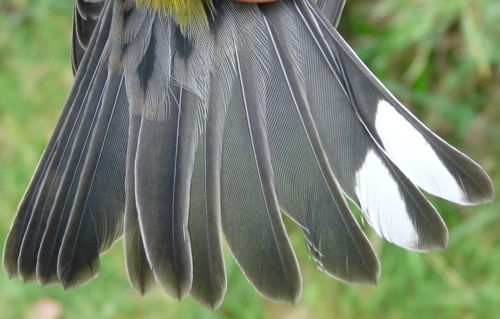
A somewhat paler tail, with a bit more brown edging on the uppertail coverts, but note
that the rectrices are broader and more rounded than expected.
Photo by Marcel Gahbauer,
McGill Bird Observatory (QC), October 2010
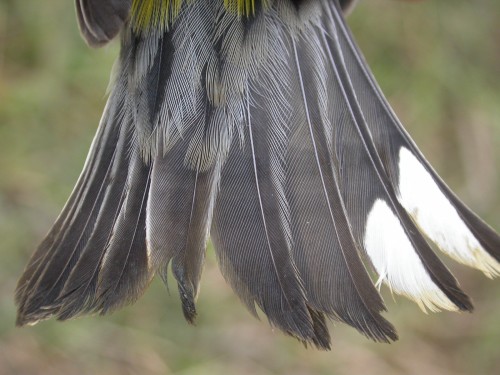
A somewhat more pointed tail, with narrower black centres to the uppertail coverts.
Photos by Marcel Gahbauer,
McGill Bird Observatory (QC), September 2005
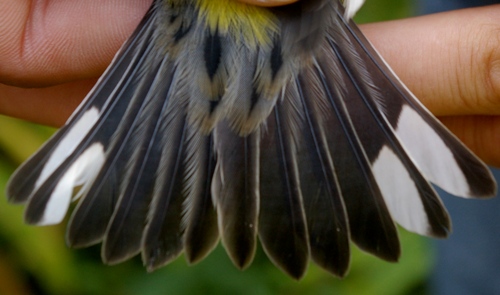
An HY female Myrtle Warbler with intermediate tail shape, but fairly extensive brown
edging on the uppertail coverts.
Photo by James Junda,
McGill Bird Observatory (QC), September 2008
RETURN TO AGE/SEX
OVERVIEW
JUN - AUG: juvenile unknown |
Juvenile Myrtle Warblers are generally brownish and quite heavily streaked below; sex can usually not be determined until after the preformative molt.
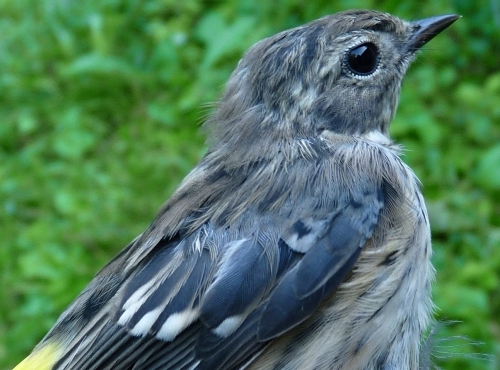
Photo by Marcel Gahbauer,
McGill Bird Observatory (QC), August 2009
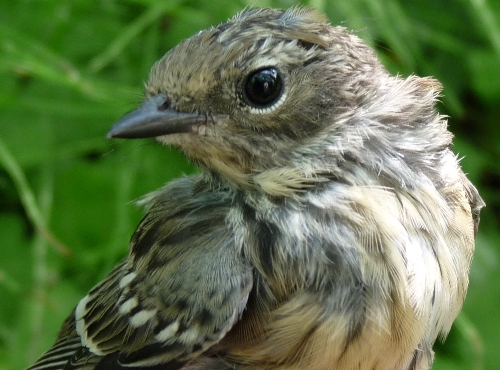
Photo by Marcel Gahbauer,
Inglewood Bird Sanctuary (AB), August 2010
Juvenile Myrtle Warblers have a relatively uniform dull gray-brown wing.
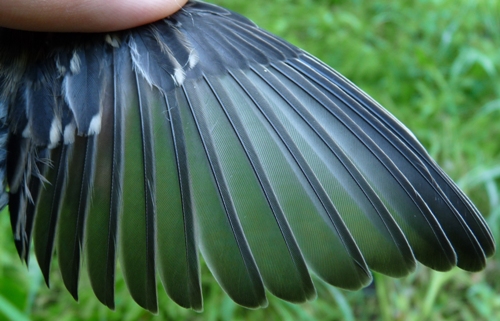
Photo by Marcel Gahbauer,
McGill Bird Observatory (QC), August 2009
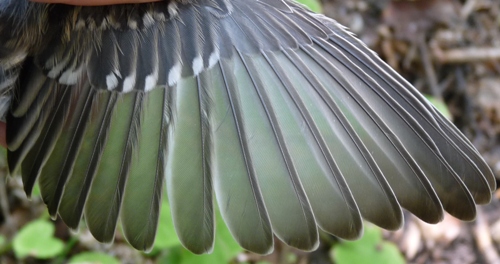
Photo by Marcel Gahbauer,
Inglewood Bird Sanctuary (AB), August 2010
The tail of juveniles tends to be relatively narrow and pointed; individuals with white limited to the outermost two rectrices are more likely to be females, while those with a fair amount of white extending to r4 are more likely males, but in most cases sex cannot be reliably determined at this age.
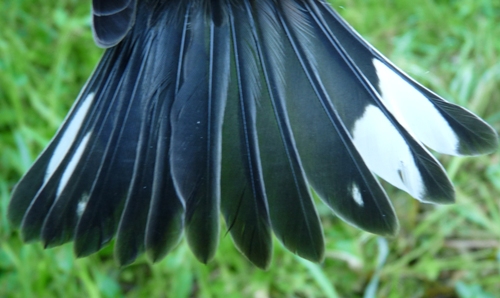
Photo by Marcel Gahbauer,
McGill Bird Observatory (QC), August 2009
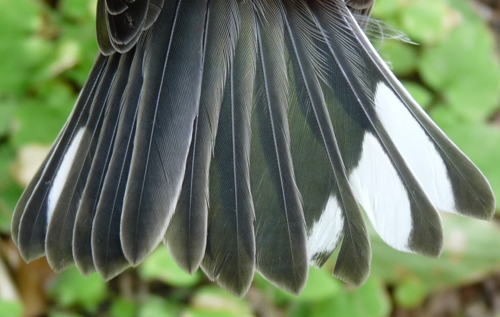
Photo by Marcel Gahbauer,
Inglewood Bird Sanctuary (AB), August 2010
RETURN TO AGE/SEX
OVERVIEW
















































































































